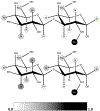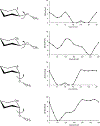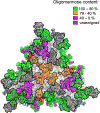Predicting the Structures of Glycans, Glycoproteins, and Their Complexes
- PMID: 30091597
- PMCID: PMC6659753
- DOI: 10.1021/acs.chemrev.8b00032
Predicting the Structures of Glycans, Glycoproteins, and Their Complexes
Abstract
Complex carbohydrates are ubiquitous in nature, and together with proteins and nucleic acids they comprise the building blocks of life. But unlike proteins and nucleic acids, carbohydrates form nonlinear polymers, and they are not characterized by robust secondary or tertiary structures but rather by distributions of well-defined conformational states. Their molecular flexibility means that oligosaccharides are often refractory to crystallization, and nuclear magnetic resonance (NMR) spectroscopy augmented by molecular dynamics (MD) simulation is the leading method for their characterization in solution. The biological importance of carbohydrate-protein interactions, in organismal development as well as in disease, places urgency on the creation of innovative experimental and theoretical methods that can predict the specificity of such interactions and quantify their strengths. Additionally, the emerging realization that protein glycosylation impacts protein function and immunogenicity places the ability to define the mechanisms by which glycosylation impacts these features at the forefront of carbohydrate modeling. This review will discuss the relevant theoretical approaches to studying the three-dimensional structures of this fascinating class of molecules and interactions, with reference to the relevant experimental data and techniques that are key for validation of the theoretical predictions.
Conflict of interest statement
The author declares no competing financial interest.
Figures












References
-
- Lemieux RU; Koto S The Conformational Properties of Glycosidic Linkages. Tetrahedron 1974, 30, 1933–1944.
-
- Thogersen H; Lemieux RU; Bock K; Meyer B Further Justification for the Exo-Anomeric Effect. Conformational Analysis Based on Nuclear Magnetic Resonance Spectroscopy of Oligosaccharides. Can. J. Chem 1982, 60, 44–57.
-
- Stuike-Prill R; Meyer B A New Force-Field Program for the Calculation of Glycopeptides and Its Application to a Heptacosapeptide-Decasaccharide ofImmunoglobulin G1. Eur.J. Biochem 1990, 194, 903–919. - PubMed
-
- Poppe L; Stuike-Prill R; Meyer B; van Halbeek H The Solution Conformation of Sialyl-Et(2 6)-Lactose Studied by Modern NMR Techniques and Monte Carlo Simulations. J. Biomol. NMR 1992, 2, 109–136. - PubMed
-
- Peters T; Meyer B; Stuike-Prill R; Somorjai R; Brisson J-R A Monte Carlo Method for Conformational Analysis of Saccharides. Carbohydr. Res 1993, 238, 49–73. - PubMed
Publication types
MeSH terms
Substances
Grants and funding
LinkOut - more resources
Full Text Sources
Other Literature Sources

